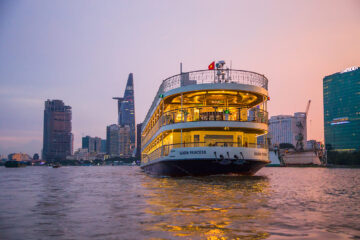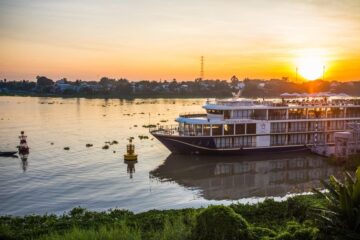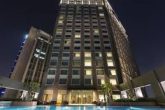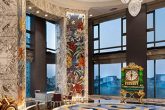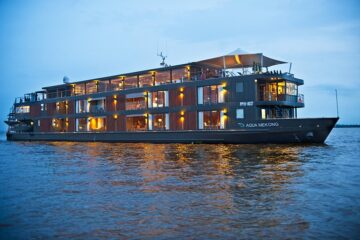Hotline: +84 913223338 - [email protected]
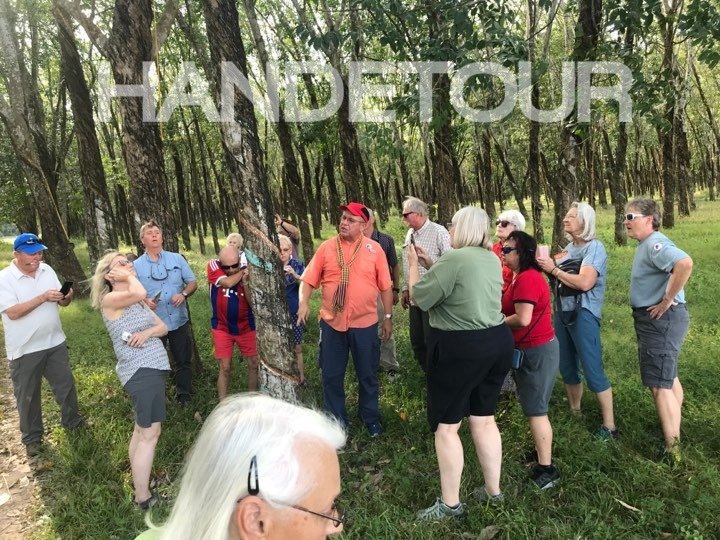
INDOCHINA DISCOVERY
- 18days/17nights
- VIENTIANE – LUANGPRABANG - PAK OU CAVE - HANOI-HALONG – HUE – HOIAN – HO CHI MINH - MEKONG – CU CHI TUNNEL - PHNOM PENH - SIEM REAP
-
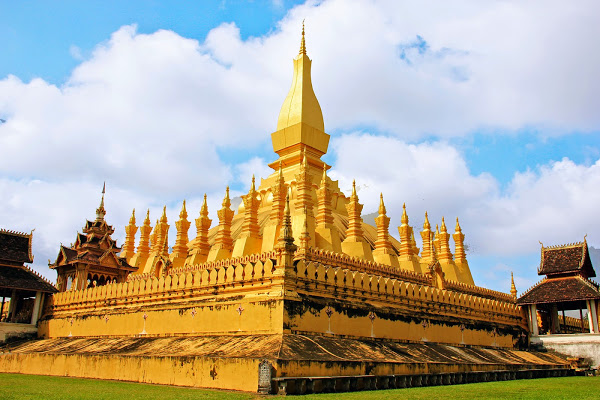 Day 1: Vientiane – Arrival (L/D)
Day 1: Vientiane – Arrival (L/D)Meals: Lunch and Dinner at local restaurant
Accommodations: at hotel
Transfer: Private vehicle
Activities for today: Upon arrival, you are met and transferred to your centrally located hotel. After a short rest, we start to visit the major sights of the capital; including the oldest Wat Sisaket with thousands of miniature Buddha statues and the former royal temple of Wat Prakeo previously housed the famous Emerald Buddha Image. On the way to the famous and sacred structure of That Luang Stupa, we stop to take some pictures of the imposing Patuxai Monument, which is well known as Vientiane’s own Arc de Triumph. From there, we visit the Central Market call ‘Morning Market’ where you can find the antique items for collection, well handmade textile and gift away items. Overnight in Vientiane.
---------------------------------------------------
+ Wat Si Saket is a Buddhist wat in Vientiane, Laos. It is situated on Lan Xang Road, on the corner with Setthathirat Road, to the northwest of Haw Phra Kaew, which formerly held the Emerald Buddha
+ Patuxai Monument: literally meaning Victory Gate or Gate of Triumph, formerly the Anousavary or Anosavari Monument, known by the French as Monument Aux Morts) is a war monument in the centre of Vientiane, Laos, built between 1957 and 1968. The Patuxai was dedicated to those who fought in the struggle for independence from France. In romanising the name from the Laotian language, it is variously transliterated as Patuxai, Patuxay, Patousai and Patusai. It is also called Patuxai Arch or the Arc de Triomphe of Vientiane as it resembles the Arc de Triomphe in Paris. However, it is typically Laotian in design, decorated with mythological creatures such as the kinnari (half-female, half-bird).
+ Talat Sao (Morning market): At the eastern corner of Lan Xang Rd. and Khu Vieng Rd. in the heart of Vientiane, the morning market is open daily from 07:00 until around 16:00. The market is two-storey and covered by several sloping roofs. It is a popular tourist destination. The market consists of many small shops, restaurants, fruit and vegetable vendors; jewellery; silk; wooden crafts; musical instruments; electronics; home appliances; housewares, CDs and DVDs/VCDs, and grocery items. Depending on the time of day and the weather conditions the market can be nearly empty or full to capacity
-
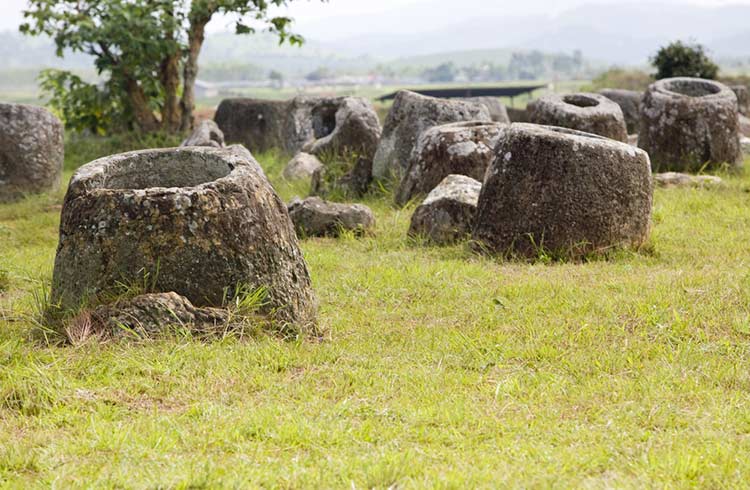 Day 2: Vientiane – Xieng Khouang (B/L) by flight
Day 2: Vientiane – Xieng Khouang (B/L) by flightMeals: Breakfast at hotel, Lunch at local restaurant
Accommodations: at hotel
Transfer: Private vehicle and flight
Activities for today:
Breakfast at hotel, free at leisure until your short afternoon flight to Xiengkhouang, which was devastated by American bombing between 1964 and 1973. Upon arrival, we transfer out to visit the Plain of Jars, an impressive archaeological site where hundreds of large stone jars are littered all over the plateau. We also have time, this afternoon seeing the old capital of Muang Khoun Province and the nearby villages, home to the Hmong hill tribe and Tai Dam people. They have an interesting local culture and a colorful history. Overnight in Phonsavanh.
-------------------------------------------------
+ The Plain of Jars is a megalithic archaeological landscape in Laos. It consists of thousands of stone jars scattered around the upland valleys and the lower foothills of the central plain of the Xiangkhoang Plateau. The jars are mostly arranged in clusters ranging in number from one to several hundred.
-
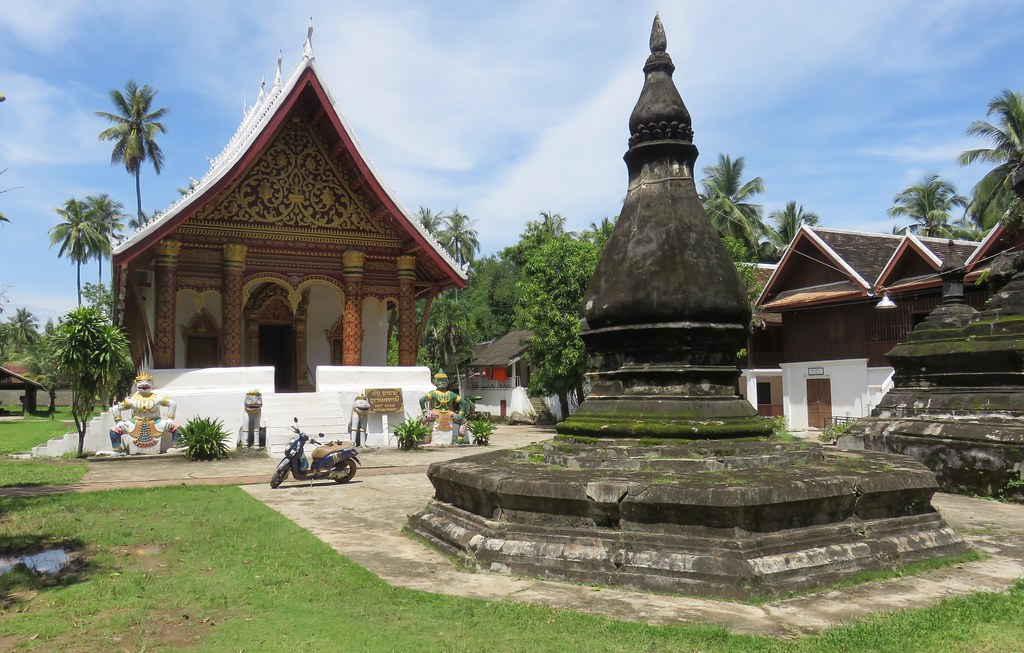 Day 3: Xieng Khouang – Luang Prabang (B/L) by road
Day 3: Xieng Khouang – Luang Prabang (B/L) by roadMeals: Breakfast at hotel, Lunch at local restaurant
Accommodations: at hotel
Transfer: Private vehicle
Activities for today: Early morning, we visit Central Market of Phonsavanh to watch different Hill Tribes to barter and exchange merchandises. Then heading out the this small town to Luang Prabang, on the way, we drop off and see a site more than 200 years old Buddha images in Thampra and varied Hmong and varied hill tribe minority villages along the road. They are nice, friendly and welcome you to visit. After a photo stop, we continue driving up hill, enjoying mountain splendid natural scenery, forest and landscape. After a tea or coffee break at Sala Phoukhoun, where the T-junction of bordering meets Vientiane-Xiengkhouang-Luang Prabang. The journey will take us over mountainous region to Luang Prabang. The tranquility and charm of this town with its splendid natural scenery and cultural sights make it one of the most delightful places to visit in Laos. After checking into hotel, [if time permits] we start seeing the impressive stupa of Wat Visoun, the shrine of Wat Aham, Wat Mai, we then climb up to the top of Phousi Mount for an enjoyable exploration of the sacred, gilded stupa as well as a beautiful sunset view of the city and the Mekong River. From there, we explore Street Night Bazaar, where you can find the lovely collection and handmade textile by local and hill tribe people surrounding Luang Prabang. Overnight in Luang Prabang.
----------------------------------------------------
+ Wat Visoun (Visounnalat): Built in 1512 or 1513, rebuilt in 1896-98 Wat Visounnalat was originally built during the reign of King Wisunarat (or Vixoun, 1501-1520) in 1513 (some suggest 1512) and represents the earliest style, sometimes referred to as Luang Prabang Style I, of Lao temple architecture. This style also includes the sims of Wat That Luang and Wat Mai. Wat Wisunalat is Luang Prabang’s oldest operating temple. As with the sims of most Lao wats, there are multiple roof structures. In the Style I form the first and second roofs extend around the entire perimeter of the structure. Except for the sim at Wat Mai, which was embellished by two additional gable roofs and two roofed side galleries, the style evokes simplicity, since the sim employs neither the high peaks of the gable nor the dramatic low sweeping roofs of many of the other sims of Luang Prabang. Located and adjoining Wat Aham to the southeast, it was probably built on the rice fields of the guardian spirits of the city (devata luang), Pu No and Na No (Phou Nheu and Nha Nheu). The sacred Prabang image was housed in the sim from 1513 until it was taken to Vientiane in 1707.
+ Wat Aham signifies "The Monastery of the Blossoming Heart". This temple was surely a place for mediation and meetings between spiritual culture and Buddhist practice. Neighbouring the Wat Vitsoun, it is relatively quiet even though the district has in the last few years, become the centre of Luang Prabang’s night life.
-
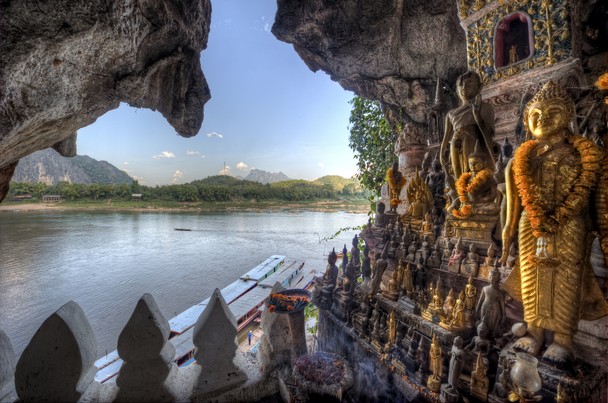 Day 4: Luang Prabang – Pak Ou Cave (B/L)
Day 4: Luang Prabang – Pak Ou Cave (B/L)Meals: Breakfast at hotel, Lunch at local restaurant
Accommodations: at hotel
Transfer: Private vehicle
Activities for today:
After breakfast, we enjoy a short-guided tour seeing the city’s oldest temple of Wat Sene and the magnificent Wat Xiengthong with its roofs sweeping low to the ground, which represent the classical architecture of Luang Prabang temple. We then board a cruise upstream on the Mekong River, which also gives us a beautiful view of the tranquil countryside as well as an interesting visit to the mysterious of Pak Ou Caves, crammed with thousands of gold lacquered Buddha statues of various shapes and sizes. Along the way, we stop at the village of Ban Xanghai, where they make the distillation of local rice wine. On return, we take a short drive to Ban Phanom, well known for its hand weaving. Overnight in Luang Prabang.
---------------------------------------------------
+ Wat Xieng Thong ("Temple of the Golden City") is a Buddhist temple (wat) on the northern tip of the peninsula of Luang Phrabang, Laos. Wat Xieng Thong is one of the most important of Lao monasteries and remains a significant monument to the spirit of religion, royalty and traditional art. There are over 20 structures on the grounds including a sim, shrines, pavilions and residences, in addition to its gardens of flowers, ornamental shrubs, and trees.
+ Pak Ou Caves: Near Pak Ou (mouth of the Ou river) the Tham Ting (lower cave) and the Tham Theung (upper cave) are caves overlooking the Mekong River, 25 km to the north of Luang Prabang, Laos. They are a group of two caves on the west side of the Mekong river, about two hours upstream from the centre of Luang Prabang, and are frequently visited by tourists.
+ Ban Phanom is a village in Luang Prabang Province, Laos. It is located 6 kilometres (3.7 mi) east of Luang Prabang. The Lue peoples of this village are noted in particular for their cotton and silk weaving. Sale to tourists is now of prime importance to the local economy. Nearby is the Tomb of Mouhot, where Henri Mouhot lies.
-
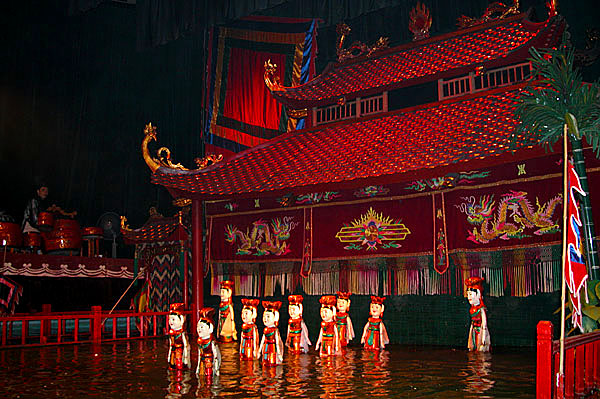 Day 5: Luang Prabang - Hanoi by flight (B/D)
Day 5: Luang Prabang - Hanoi by flight (B/D)Meals: Breakfast at hotel, Dinner at local restaurant
Accommodations: at hotel
Transfer: Private vehicle and flight
Activities for today:
Breakfast, visit the National Museum at the former Royal Palace, which displays a lovely collection of the artifacts reflecting the richness of Lao culture dating from the days of the early kings right through the last sovereign, and the Central Market are not to be missed. We visit these sights in the morning before flying to Hanoi. You are warmly welcomed by our Tour guide at Noibai Airport and transferred to your hotel in Hanoi capital. Be free and relax after long journey. In the evening, attend Water Puppet Show and enjoy welcome dinner. Overnight in Hanoi.
---------------------------------------------------
+ The National Museum (former The Royal Palace) in Luang Prabang, Laos, was built in 1904 during the French colonial era for King Sisavang Vong and his family. The site for the palace was chosen so that official visitors to Luang Prabang could disembark from their river voyages directly below the palace and be received there. After the death of King Sisavang Vong, the Crown Prince Savang Vatthana and his family were the last to occupy the grounds. In 1975, the monarchy was overthrown by the communists and the royal family were taken to re-education camps. The palace was then converted into a national museum.
+ Water Puppet Show: It is a tradition that dates back as far as the 11th century CE when it originated in the villages of the Red River Delta area of northern Vietnam.
-
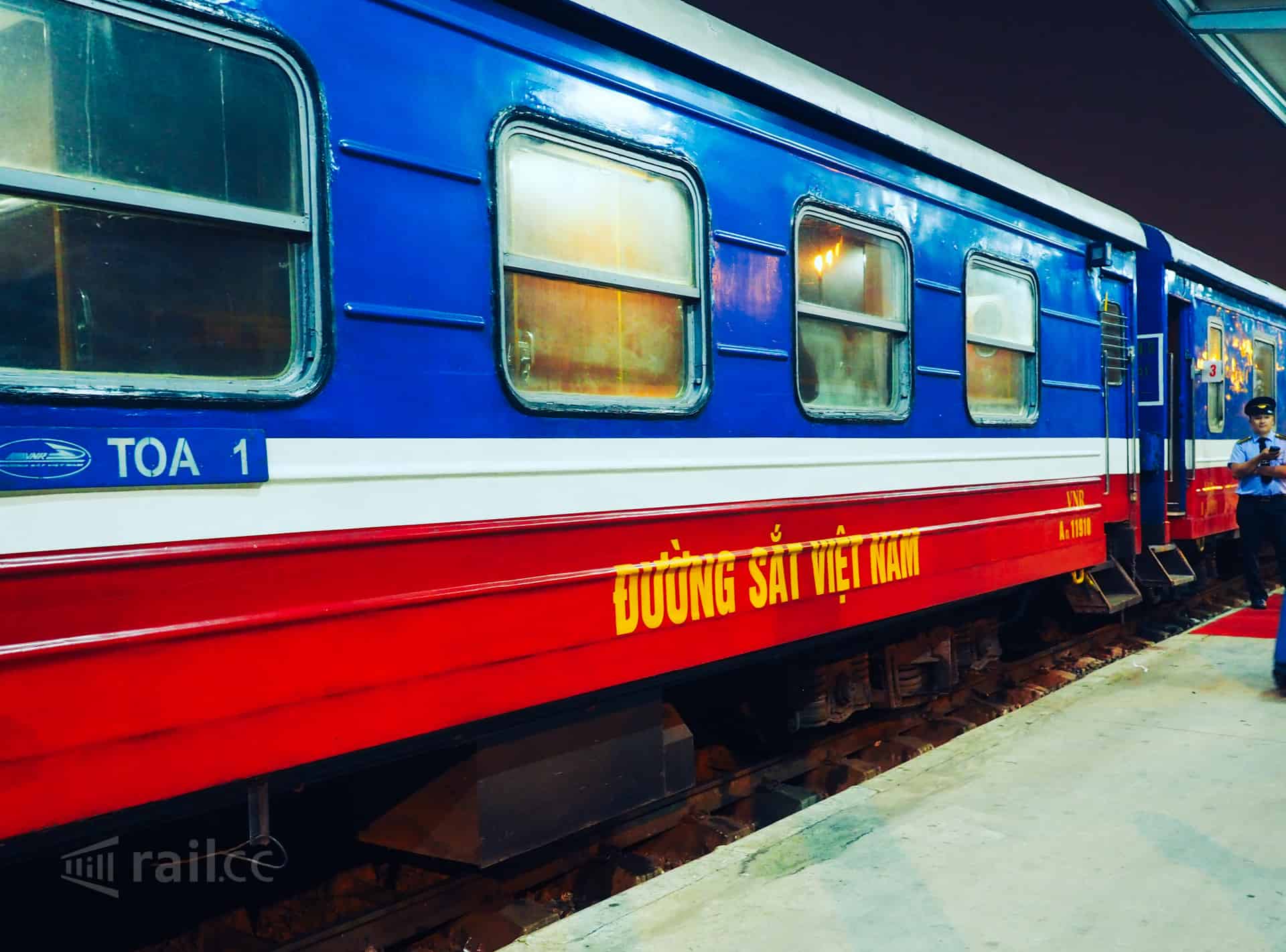 Day 6: Hanoi city tour - Laocai (B/L) by train
Day 6: Hanoi city tour - Laocai (B/L) by trainMeals: Breakfast at hotel, Lunch at local restaurant
Accommodations: on train
Transfer: Private vehicle and train
Activities for today:
Enjoy breakfast at hotel, Start at 8:00 from your hotel by car to visit Ho Chi Minh Mausoleum, stilt-house and Museum, One pillar pagoda, Tran Quoc pagoda, temple of Literature- the first university of Vietnam. After the lunch time, visit to the Ethnology museum where contains more than 10,000 objects, 15,000 black and white photos and hundreds of video tapes and cassettes which depict all aspects of life, activities, customs, and habits of the 54 ethnic groups of Vietnam. Wonder around Hoan Kiem lake then visit Ngoc Son Temple and enjoy one hour cyclo trip around the trading area in Hanoi Old Quarter. Have dinner at local restaurant then transfer to train station take night train to Sapa. Overnight on train.
---------------------------------------------------
+ Ho Chi Minh Mausoleum: It holds the embalmed remains of Ho Chi Minh. Visiting the Ho Chi Minh Mausoleum is a highlight for many locals' visits to the capital, and very few Vietnamese visiting Hanoi pass up a chance for a pilgrimage to the place where Vietminh leader Ho Chi Minh read the Declaration of Independence. It is closed every Monday and Friday, November and December closed for maintain.
+ Ho Chi Minh's House on Stilts: It is the house president Ho Chi Minh lived on and off from 1958 to 1969. It was constructed by the official French architect for Vietnam. Like most French Colonial architecture, the palace is pointedly European. The house is an interpretation of a traditional rural dwelling, and has been preserved just as Ho left it.
+ One Pillar Pagoda: It is a Buddhist temple in the Ho Chi Minh Mausoleum complex near Ba Dinh Square, a replica of an older temple that was built in 1049 and destroyed in 1954.It is regarded alongside the Perfume Temple, as one of Vietnam's two most iconic temples.
+ Temple of Literature: It is a temple of Confucius in Hanoi. The temple hosts the "Imperial Academy", Vietnam's first national university. The various pavilions, halls, statues and stelae of doctors are places where offering ceremonies, study sessions and the strict exams of the Dai Viet took place.
+ Museum of Ethnology: It focuses on the 54 officially recognized ethnic groups in Vietnam. It is widely considered to be the finest modern museum in Vietnam and a tourist attraction in Hanoi.
+ Hoan Kiem Lake ("Lake of the Returned Sword" or "Lake of the Restored Sword"), also known as Hồ Gươm (Sword Lake), is a fresh water lake, measuring some 12 ha in the historical center of Hanoi, the capital city of Vietnam.
+ Ngoc Son Temple was built in the 18th century on Jade Island in the centre of the ‘Lake of the Returned Sword’ or Hoan Kiem Lake. Legend describes how an emperor was once given a magical sword which helped him defeat the Chinese Ming Dynasty and in doing so saw the return of the Golden Turtle God to the lake.
-
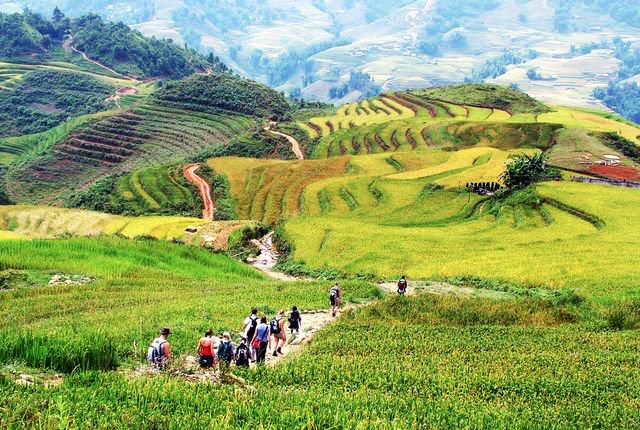 Day 7: Lao Cai - Sapa - Cat Cat Village (B/L/D)
Day 7: Lao Cai - Sapa - Cat Cat Village (B/L/D)Meals: Breakfast, Lunch and Dinner at local restaurant
Accommodations: at hotel
Transfer: Private vehicle
Activities for today:
Arrive at Lao Cai train station at about 5.30. Take a transfer to Sapa. (Check in at 14:00PM, free early check in subject to availability). Freshen up after a long trip with breakfast in the good weather of Sapa, then, visit Sapa town. In the afternoon, take a 2km short trek to Cat Cat Village, the home of H’mong minority, have dinner at local restaurant. Overnight in Sapa town.
--------------------------------------------------
+ Cat Cat Village is a Hmong village that is only 2km away from the center. This is the most attractive tourist spot in Sapa all year around. It was first built to be a relaxation resort where all the majors and captains would come to stay over for the holiday back in the 19th century when Vietnam still belonged to the French.
-
 Day 8: Sapa - Lao Chai, Ta Van Village - Hanoi (B/L) by train
Day 8: Sapa - Lao Chai, Ta Van Village - Hanoi (B/L) by trainMeals: Breakfast at hotel and Lunch at local restaurant
Accommodations: on train
Transfer: Private vehicle
Activities for today
After breakfast at hotel, short drive to visit Lao Chai and Ta Van Villages, home of H’mong and Day ethnic. Enjoy slope rice field, bamboo valley, rustic villages and villager's daily work along the way. Return to Sapa and take a transfer back to Lao Cai station for night train to Hanoi. Overnight on train.
----------------------------------------------------
+ Lao Chai Village: is home to the ethnic Giay with more than 40 households and a few other ethnic minority people. They live in the lowlands, the valleys near rivers and streams to cultivate rice. On the other hand, the Mong people prefer high places to grow upland rice, tapioca, and maize. In front of the village is the beautiful Muong Hoa stream and in the behind is the majestic Hoang Lien Mountains.
Lao Chai with the majestic beauty of terraced fields, waterfalls, and mountains is a very ideal place for trekking activities to explore the beauty of Sapa. Trekking to the villages not only helps you enjoy the whole beauty of the nature of Sapa clouds but also helps you understand more about life as well as customs, lifestyle, and culture of the people here.
+ Ta Van village is actually a small community with hospitable, amiable and friendly people living together at peace. They scatter at the foot the of the mountain, the valleys or along the streams. They live on growing rice and producing instruments as well as engraved silver.
Time has gone by and people in Ta Van village’s tradition and culture have been well-preserved. They love in traditional stilted houses with a solemn room as a place to show respect and a great attitude to their ancestors. The beauty of the landscape as well as people has become a rich source of inspiration for various cultural fairy-tale, riddles, proverbs and poetry.
In Ta Van village, tourist will be overwhelmed by the quiet space and extremely peaceful that contrast completely when in the center of Sapa. The terraced fields are covered with rice and the color of the trees makes the landscape very attractive and special.
-
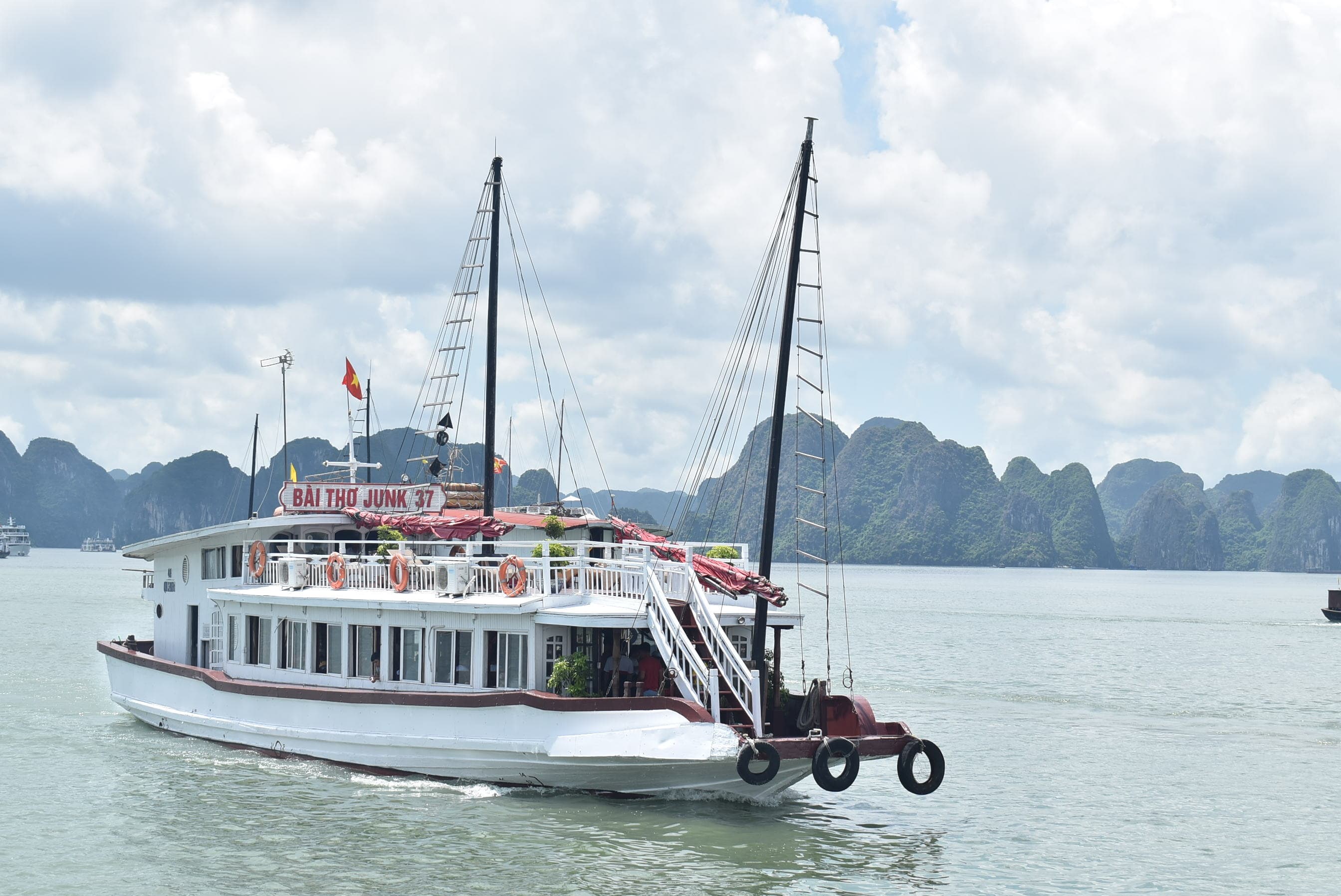 Day 9: Hanoi – Halong bay - Hanoi (B/L)
Day 9: Hanoi – Halong bay - Hanoi (B/L)Meals: Breakfast at local restaurant and Lunch on cruise
Accommodations: at hotel
Transfer: Private vehicle and boat
Activities for today:
Arrival in Hanoi at 5.00, the tour guide will pick up you, have breakfast at restaurant, then leave Hanoi at 8:00 for Halong Bay, on arrival at Halong city at about 11.30am, get on a private boat. Have seafood lunch on boat while the boat cruising caves, grottoes, floating villages and beaches. Stop to visit Thien Cung or Dau Go Caves, one of the biggest, nicest cave in Halong Bay. Finish cruise about 15.30pm. Drive back to Hanoi. Overnight in Hanoi.
--------------------------------------------------
+ Thien Cung cave: It is situated on the south-west side the bay, 4 km from the wharf outside of Ha Long City. The way to Thiên Cung is a perilous one, covered on both sides by thick forest. After entering a narrow gate, the grotto’s 130-meter-long girth opens up. Getting in we are more astonished in front of the very animated and splendid beauty which is made from stalactite. On the east wall of the grotto, there is a grandiose and imposing picture with characters of tales.
Going out of the Thiên Cung Grotto, we have a sensation of just watching a unique, meticulous, interesting fine-art museum which is made by nature, get out of the imagine, ability and intellect of man.
This grotto is recently discovered, one of the most beautiful grottoes in Ha Long Bay.
+ Dau Go Cave: The grotto is on Driftwood Island. Seen from afar, the entrance to the grotto appears to be blue, and has a shape similar to that of a jellyfish. After 90 steps up the island, the entrance is reached. The ceiling of the grotto is about 25 m. Hundreds of stalactites falling down from the roof of the grotto look like a waterfall. The grotto is divided into three main parts.
The exterior is a room with a vault full of natural light. Many forms may be seen in the rock formations of the chamber, depending on the imagination of the visitor of course.
Crossing the first chamber, one enters the second chamber through a narrow passage. The light here is mysterious, and new images appear in the stone. It makes us having a fear and be inquisitive.
The third chamber of the grotto is widely opened. At the end of the grotto is a well of clear water. Looking up in the dim light we recognize that surrounded is the image of an ancient citadel and a scuffle of elephants, horses, man with bristly sword and spear. All are making a rush and be petrified suddenly.
-
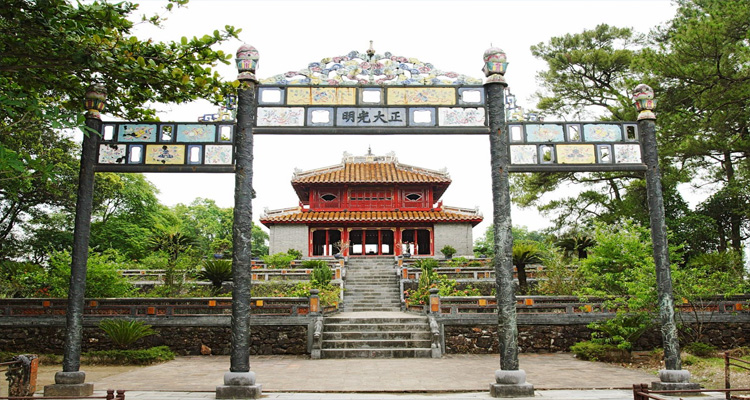 Day 10: Hanoi - Hue by flight (B/L/D)
Day 10: Hanoi - Hue by flight (B/L/D)Meals: Breakfast at hotel, Lunch and Dinner at local restaurant
Accommodations: at hotel
Transfer: Private vehicle and flight
Activities for today:
After breakfast at hotel, we will transfer to airport, take the flight to Hue city, start the tour with a visit to Imperial Citadel and King Minh Mang tomb, King Tu Duc Tomb, Thien Mu Pagoda. Then we will embark a boat cruise along Perfume river to admire sunset and enjoy Vietnamese traditional folk song on boat. Overnight in Hue.
--------------------------------------------------
+ Imperial Citadel: The former imperial seat of government and Hue's prime attraction, this is a great sprawling complex of temples, pavilions, moats, walls, gates, shops, museums and galleries, featuring art and costumes from various periods of Vietnamese history. Thanks to its size, it is also delightfully peaceful - a rare commodity in Vietnam. It is pretty huge; plan to spend at least 3 hours there.
+ King Tu Duc Tomb: Constructed from 1864 to 1867, the complex served as a second Imperial City where the Emperor went for "working vacations". Tu Duc's contemplative nature and poetic spirit is reflected in the landscape and arrangement of the 50 buildings that at one time stood here. A vast, sprawling complex set around a lake, with wooden pavilions and tombs and temples dedicated to wives and favored courtesans (Tu Duc had 104 to choose from).
+ Thien Mu Pagoda: Built in 1601 between a river and a pine forest, the Thien Mu Pagoda ("Heavenly Lady Pagoda") in Hue is one of the oldest and prettiest religious buildings in the country.
+ Perfume River: It is a river that crosses the city of Hue. In the autumn, flowers from orchards upriver from Hue fall into the water, giving the river a perfume-like aroma, hence the soubriquet.
+ Royal Tomb of King Ming Mang: It is the final resting place of one of the Nguyen Dynasty's staunchest Confucians, whose reign represents the apex of Nguyen power over the country.
-
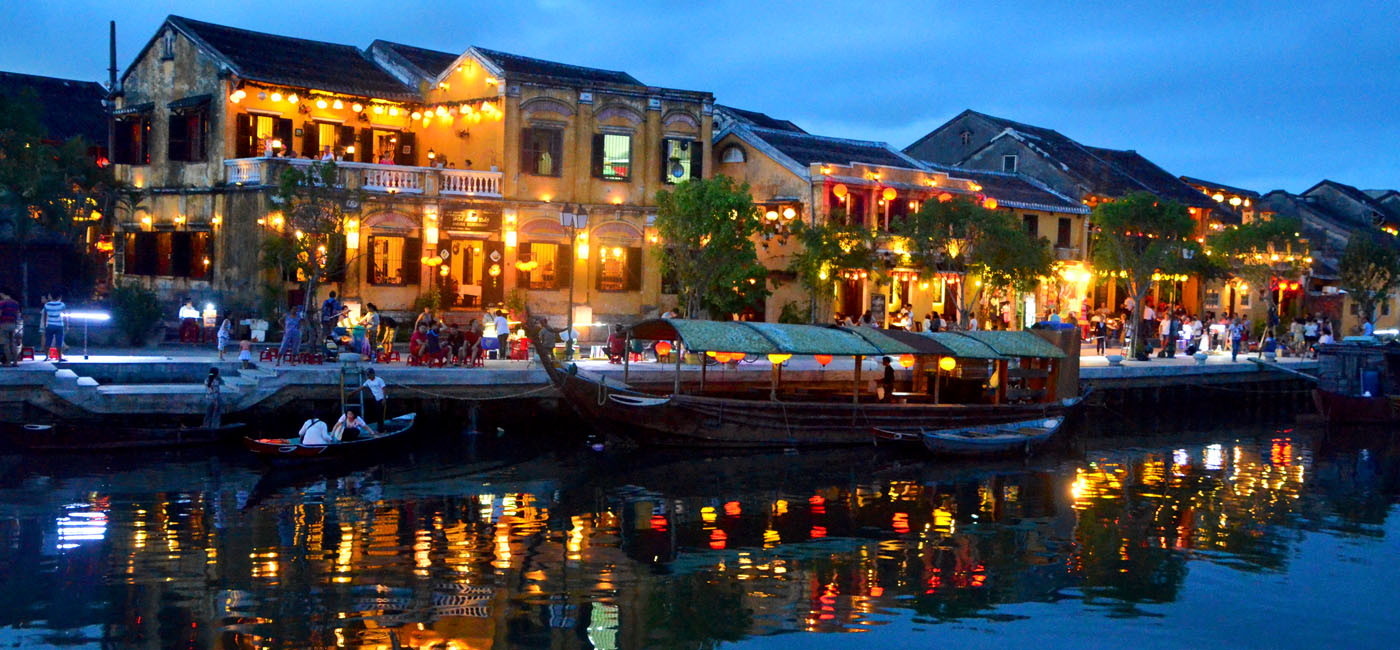 Day 11: Hue - Hoian (B/L)
Day 11: Hue - Hoian (B/L)Meals: Breakfast at hotel, Lunch at local restaurant
Accommodations: at hotel
Transfer: Private vehicle
Activities for today:
Morning drive to Hoi An through Hai Van pass, Lang Co beach – one of the most beautiful beaches of Vietnam. Visit Cham museum on the way, Cham museum is the open air collection of Cham sculpture with many of the sandstone carvings. After check-in, visit the Ancient town. Overnight in Hoi An.
-------------------------------------------------
+ The Hai Van Pass: is an approximately 21 km long mountain pass on National Route 1A in Vietnam. It traverses a spur of the larger Annamite Range that juts into the East Sea of Viet Nam, on the border of Đà Nẵng and Thừa Thiên–Huế Province, near Bạch Mã National Park. Its name refers to the mists that rise from the sea, reducing visibility. Historically, the pass was a physical division between the kingdoms of Champa and Đại Việt.
+ Hoi An ancient town: is an exceptionally well-preserved example of a South-East Asian trading port dating from the 15th to the 19th century. Its buildings and its street plan reflect the influences, both indigenous and foreign, that have combined to produce this unique heritage site.
-
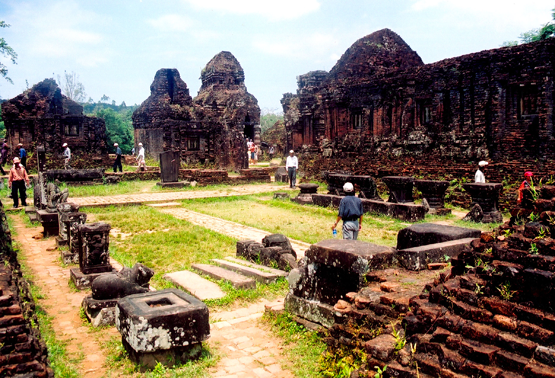 Day 12: Hoian – My Son Holy Land (B/L)
Day 12: Hoian – My Son Holy Land (B/L)Meals: Breakfast at hotel, Lunch at local restaurant
Accommodations: at hotel
Transfer: Private vehicle
Activities for today:
In the morning, take a private car from Hoi An town to My Son Holy Land – one of the world heritage site of Vietnam. Back to Hoi An for lunch. Leisure time in the afternoon for beach activities or relax on the bank of Thu Bon river or go shopping around. Overnight in Hoi An.
---------------------------------------------------
+ My Son Holy Land: is a cluster of abandoned and partially ruined Hindu temples in Vietnam, constructed between the 4th and the 14th century AD by the kings of Champa (Chiêm Thành in Vietnamese). The temples are dedicated to the worship of the god Shiva, known under various local names, the most important of which is Bhadreshvara.
Mỹ Sơn is located near the village of Duy Phú, in the administrative district of Duy Xuyên in Quảng Nam Province in Central Vietnam, 69 km southwest of Da Nang, and approximately 10 km from the historic town of Trà Kiệu. The temples are in a valley roughly two kilometres wide that is surrounded by two mountain ranges.
From the 4th to the 14th century AD, the valley at Mỹ Sơn was a site of religious ceremony for kings of the ruling dynasties of Champa, as well as a burial place for Cham royalty and national heroes. It was closely associated with the nearby Cham cities of Indrapura (Đồng Dương) and Simhapura (Trà Kiệu). At one time, the site encompassed over 70 temples as well as numerous stele bearing historically important inscriptions in Sanskrit and Cham.
-
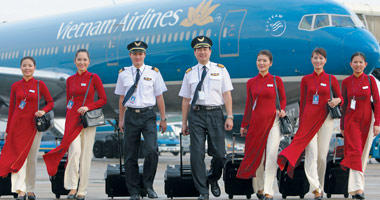 Day 13: Hoian - Danang – Ho Chi Minh by flight (B)
Day 13: Hoian - Danang – Ho Chi Minh by flight (B)Meals: Breakfast at hotel
Accommodations: at hotel
Transfer: Private vehicle and flight
Activities for today:
Have a breakfast at hotel, free time in the beach. Then we will transfer to Da Nang Airport to fly to Ho Chi Minh around noon. Overnight in Ho Chi Minh.
-
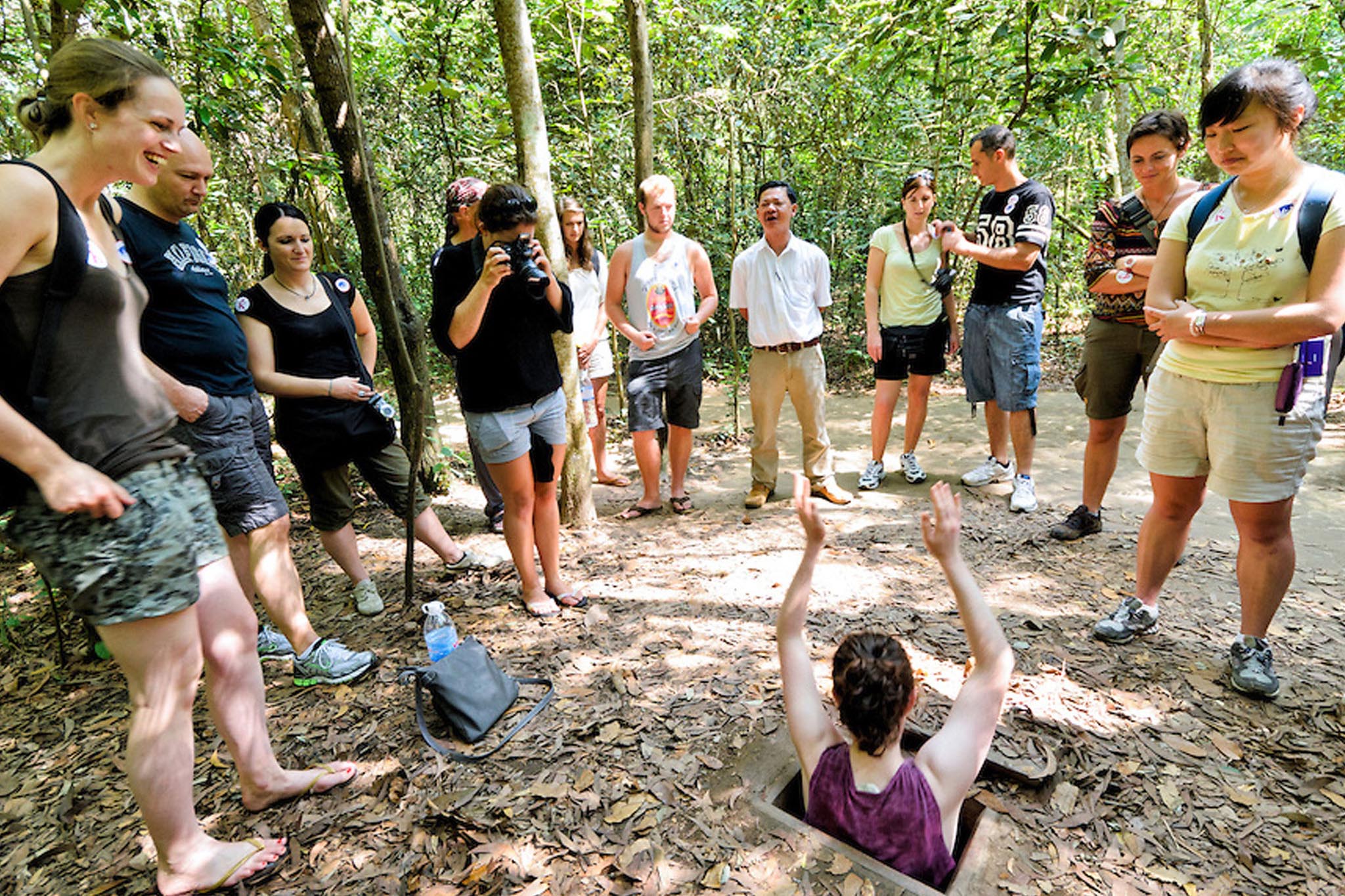 Day 14: Ho Chi Minh - Cu Chi Tunnel – city tour (B/L)
Day 14: Ho Chi Minh - Cu Chi Tunnel – city tour (B/L)Meals: Breakfast at hotel, Lunch at local restaurant
Accommodations: at hotel
Transfer: Private vehicle
Activities for today:
After breakfast at hotel, 08:00AM drive a long way on the country side of Vietnam to Cu Chi, the incredible underground tunnel network constructed by Vietnamese fighters during the long struggle for independence. Return to Ho Chi Minh. Have lunch at restaurant. Then, the tour begins with a visit to Reunification Palace, Notre Dame Cathedral. On the way back, stop at Chinatown which should not be missed. Overnight in Ho Chi Minh City.
--------------------------------------------------
+ Cu Chi Tunnels: This tunnel system was established and used by the Vietcong during the war of independence. From 1988, two sections of tunnels have been open for Vietnam tours visitors. This gigantic underground network connects villages around, making it a wonderful destination for all kinds of Vietnam tours.
+ Reunification Palace: Reunification Palace formerly known as Independence Palace, built on the site of the former Norodom Palace, is a landmark in Ho Chi Minh City. It was the home and workplace of the President of South Vietnam during the Vietnam War.
+ Notre Dame Cathedral: Constructed by the French in the 1800s, the Notre Dame Cathedral in Ho Chi Minh City appears strangely out of place with its Gothic and Roman-style architecture. Twin towers reaching to 190 feet capture the interest of people strolling by.
-
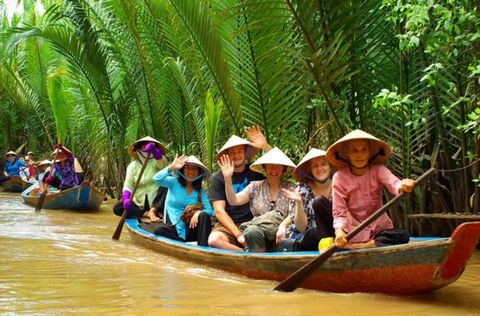 Day 15: Ho Chi Minh - Mekong delta- Ho Chi Minh (B/L)
Day 15: Ho Chi Minh - Mekong delta- Ho Chi Minh (B/L)Meals: Breakfast at hotel, Lunch at local restaurant
Accommodations: at hotel
Transfer: Private vehicle and boat
Activities for today:
Have breakfast at hotel, 08:00AM drive to My Tho (about 70-75km), on arrival, get on a private boat cruising along small creek to Mekong River estuary, to Phoenix Island. The motorized boat cruises more along natural creeks and quiet village in Ben Tre Province. Visit orchards, bee - keeping farm, taste natural honey and honey wine, enjoy tropical fruit, traditional music, wonder around a distillery, explore the local coconut candy production process, taste candy & coconut pulp. Have dinner at Indian restaurant. Overnight in Ho Chi Minh.
--------------------------------------------------
+ My Tho is the capital city, center of economics, education and technology of Tiền Giang Province, located in the Mekong Delta region of South Vietnam. The majority ethnic group is the Kinh, and some of the Chinese, the Cham and the Khmer. Boat rides on the Mỹ Tho River are popular with tourists, and the city is known for hủ tiếu Mỹ Tho, a type of rice noodle soup.
-
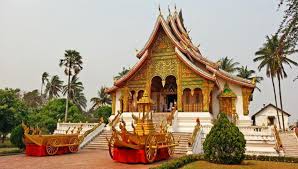 Day 16: Ho Chi Minh – Phnom Penh by flight (B/L/D)
Day 16: Ho Chi Minh – Phnom Penh by flight (B/L/D)Meals: Breakfast at hotel, Lunch and Dinner at local restaurant
Accommodations: at hotel
Transfer: Private vehicle and flight
Activities for today:
After breakfast at hotel, we will transfer to airport, take the flight to Phnom Penh
Upon arrival at Phnom Penh airport, you will be met and transferred to your hotel. Visit to Royal Palace, Silver Pagoda, Independence Monument, National Museum and Wat Phnom. Overnight in Phnom Penh.
---------------------------------------------------
+ The Royal Palace is a complex of buildings which serves as the royal residence of the king of Cambodia. The Kings of Cambodia have occupied it since it was built in the 1860s, with a period of absence when the country came into turmoil during and after the reign of the Khmer Rouge.
+ Wat Preah Keo Morakot (Silver Pagoda) is located in the southern portion of the Royal Palace complex. The pagoda was formerly known as Wat Uborsoth Rotannaram because it is where the King worshiped, prayed and practiced every Buddhist Silas Day. In the additional, the royal family and officials also held Buddhist ceremonies there.This pagoda has no monks.
+ The Independence Monument was built in 1958 to memorialize Cambodia's independence from France in 1953. It stands on the intersection of Norodom Boulevard and Sihanouk Boulevard in the centre of the city. It is in the form of a lotus-shaped stupa, of the style seen at the Khmer temple at Banteay Srei and other Khmer historical sites. The Independence Monument was designed by the Cambodian architect Vann Molyvann. It stands 37 meters tall.
+ The National Museum of Cambodia in Phnom Penh is Cambodia's largest museum of cultural history and is the country's leading historical and archaeological museum.
+ Wat Phnom was built in 1372, and stands 27 metres (88.5 ft) above the ground. It is the tallest religious structure in the city. The pagoda was given the name of Wat Preah Chedey Borapaut. Wat Phnom is the central point of Phnom Penh.
-
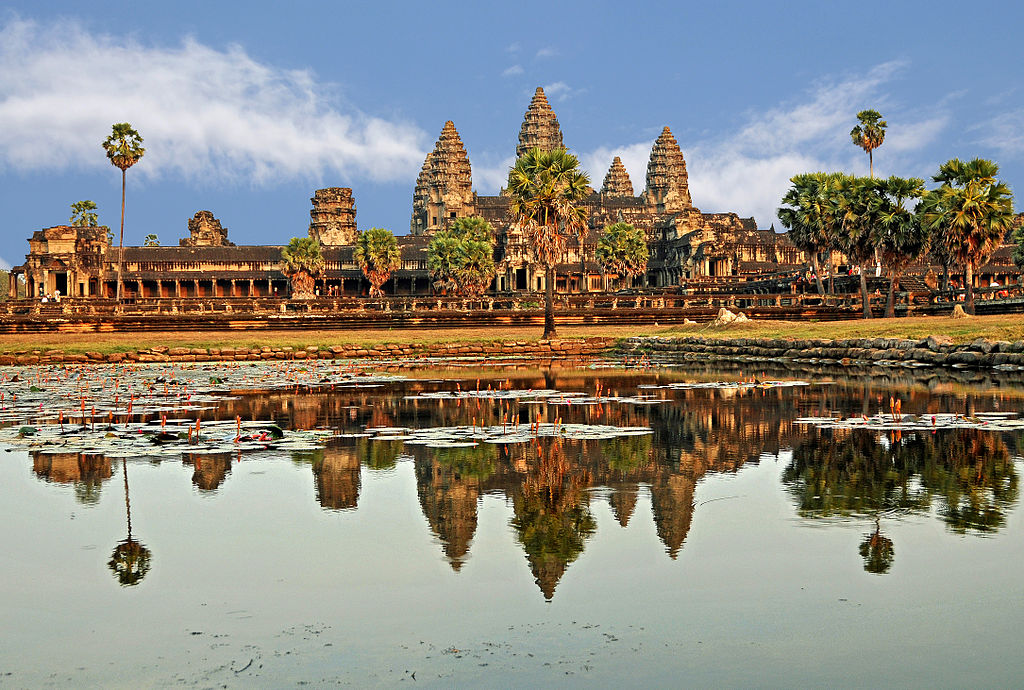 Day 17: Phnom Penh – Siem Reap (B/-/D)
Day 17: Phnom Penh – Siem Reap (B/-/D)Meals: Breakfast at hotel, Lunch at local restaurant
Accommodations: at hotel
Transfer: Private vehicle and ferry
Activities for today:
Breakfast at hotel, then transfer to Phnom Penh Ferry for departure to Siem Reap (07:30 – 13:30). Upon arrival in Siem Reap, you will be met and transfer to hotel. It is time to visit the world wonder of Angkor Wat and sunset from Phnom Bakheng Hill. Dinner Apsara dinner show at local restaurant. Overnight in Siem Reap.
-------------------------------------------------
+ Angkor Wat: Angkor Wat is the largest and most breathtaking monument at Angkor. Built as the funerary temple for Suryavarman II, who ruled from 1112 to 1152, Angkor never fails to reward the Cambodia tour fans with its grand scale, surreal bas reliefs and unbelievable attention to detail.
+ Phnom Bakheng at Angkor, Cambodia, is a Hindu and Buddhist temple in the form of a temple mountain. Dedicated to Shiva, it was built at the end of the 9th century, during the reign of King Yasovarman (889-910). Located atop a hill, it is nowadays a popular tourist spot for sunset views of the much bigger temple Angkor Wat, which lies amid the jungle about 1.5 km to the southeast. The large number of visitors makes Phnom Bakheng one of the most threatened monuments of Angkor.
+ Apsara dance show - the traditional dance of Khmer people arrived in Cambodia about 2000 years ago (century 1) along with Hinduism. Both were developing rapidly in Angkor era. Apsara quickly became indispensible in every special occasion and event to honor Hinduism Gods. It’s estimated there were about 3000 Apsara dancers during Jayavarman Empire. This was an incredible number in comparison with the country’s population at that time. Nowadays, Apsara dance performances are shorter, opener and more comfortable than the classic ones but they still keep their perfect movements and the sensitive soul of the classic dances. Apsara dancers who are charming and full are symbols of Khmer spirit. As a famous dance of elegance, nobility and softness, every movement displays a balance in soul, no frustration or rush. In performances, Apsara dancers wear tight shirts in bright colors, traditional sampot skirts, and hat in temple-shape which is golden and decorated very sophisticatedly. To be Apsara dancers, women must have fit body, not too skinny or too fat. Especially, their hands and fingers should be small, long and tapering, lung should be straight, and waist should be small.
-
 Day 18: Siem Reap - Departure (B/L)
Day 18: Siem Reap - Departure (B/L)Meals: Breakfast at hotel, Lunch at local restaurant
Transfer: Private vehicle
Activities for today:
Breakfast at hotel, We continue to visit South Gate of Angkor Thom, the famous Bayon, Baphoun, the Terrace of Temple, Elephants and Terrace of the Leper King the fabulous Ta Prohm embraced by the roots of enormous fig trees and gigantic creepers, Pre Rup, East Mebon, Neak Poan. Transfer to Siem Reap Airport for departure. End of services.
---------------------------------------------------
+ South Gate of Angkor Thom: The south gate of Angkor Thom is 7.2 km north of Siem Reap, and 1.7 km north of the entrance to Angkor Wat. The walls, 8 m high and flanked by a moat, are each 3 km long, enclosing an area of 9 km2. You can see the giant statues in line at the both sides of the gate, gods in a line and the other are devils.
+ Bayon Temple: It is a well-known and richly decorated Khmer temple at Angkor in Cambodia. The Bayon's most distinctive feature is the multitude of serene and massive stone faces on the many towers which jut out from the upper terrace and cluster around its central peak. The temple is known also for two impressive sets of bas-reliefs, which present an unusual combination of mythological, historical, and mundane scenes.
+ Elephants Terrace: Elephants Terrace was used by Angkor's king Jayavarman VII as a platform from which to view his victorious returning army. It was attached to the palace of Phimeanakas, which only a few ruins remain.
+ Ta Prohm Temple: The photogenic and atmospheric combination of trees growing out of the ruins and the jungle surroundings have made it one of Angkor's most popular temples with visitors. It is famous because of the film "Tomb Raider" also.
Rates vary frequently depending on group size, travel time, accommodation level, transportation and special touring requirements! Please contact us at [email protected] to get the best possible price.
- Private car
- Private VIP boat in Halong
- English speaking tour guide at each destination
- Accommodation with daily breakfast (Check in at 14:00; check out at 12:00)
- Meals as indicated (B=Breakfast, L=Lunch, D=Dinner)
- Domestic flight tickets within Indochina (Vientaine –Xiengkhouang; Luanprabang – Hanoi – Hue; Danang – Ho Chi Minh – Phnom Penh )
- Airport tax included
- Daily bottle of mineral water.
- All activities mentioned
- All service charge and government tax
- Boat trip to Pak ou Cave
- Insurance (Highly recommend to take your own insurance before your departure)
- Personal expenses
- Visa on arrival 30 USD /Person in Laos
- Telephone, drinks , and other expending
- International flight tickets
- Early check in and late checkout at hotels
- Single room
- TIPs
-
Day 1: Vientiane – Arrival (L/D)
-
Day 2: Vientiane – Xieng Khouang (B/L) by flight
-
Day 3: Xieng Khouang – Luang Prabang (B/L) by road
-
Day 4: Luang Prabang – Pak Ou Cave (B/L)
-
Day 5: Luang Prabang - Hanoi by flight (B/D)
-
Day 6: Hanoi city tour - Laocai (B/L) by train
-
Day 7: Lao Cai - Sapa - Cat Cat Village (B/L/D)
-
Day 8: Sapa - Lao Chai, Ta Van Village - Hanoi (B/L) by train
-
Day 9: Hanoi – Halong bay - Hanoi (B/L)
-
Day 10: Hanoi - Hue by flight (B/L/D)
-
Day 11: Hue - Hoian (B/L)
-
Day 12: Hoian – My Son Holy Land (B/L)
-
Day 13: Hoian - Danang – Ho Chi Minh by flight (B)
-
Day 14: Ho Chi Minh - Cu Chi Tunnel – city tour (B/L)
-
Day 15: Ho Chi Minh - Mekong delta- Ho Chi Minh (B/L)
-
Day 16: Ho Chi Minh – Phnom Penh by flight (B/L/D)
-
Day 17: Phnom Penh – Siem Reap (B/-/D)
-
Day 18: Siem Reap - Departure (B/L)
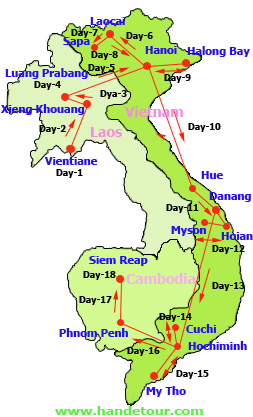
1. We are a real local tour operator and we understand our country more than others.
2. We are a legal company authorized by Vietnam Administration Of Tourism # 01-380
3. We are an official member of PATA # 6989, VITA # 2436, ASTA # 900169082, VCCI # 6178
4. We design your own itinerary without any charges, no matter how many changes.
5. We reply your request within 01 working day to save your valued time.
6. We provide qualified staff, experienced tour guide, well-maintained vehicles, good restaurants, best hotels
7. We only focus on high quality and luxury travel services to ensure our standard.
8. Listen to our customers' saying about us to see how they are satisfied with our services.
Similar Tours
